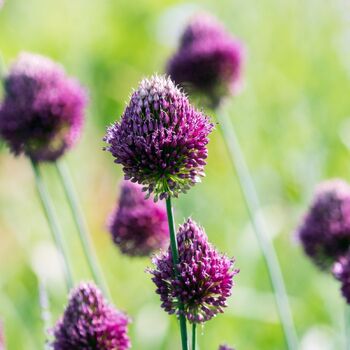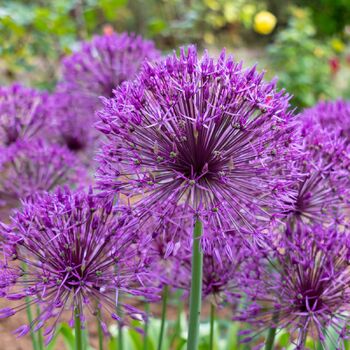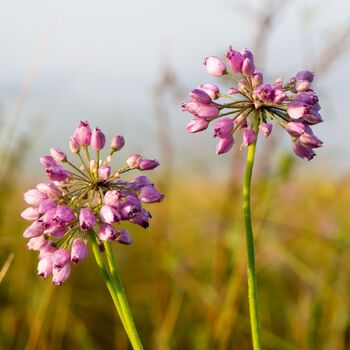
How to Grow Allium (Flowering Onion) Bulbs
Grow Guide #2609
Family: Amaryllidaceae
Binomial name: Allium sp.
Life Cycle: Perennial
This 'How to Grow' guide details everything a home gardener needs to know to plant, grow and care for Allium (flowering onion) (Allium sp.).
When to Plant Allium (Flowering Onion) Bulbs
Use the table below to identify the best time of year to plant allium (flowering onion) bulbs in your climate.
| JAN | FEB | MAR | APR | MAY | JUN | JUL | AUG | SEP | OCT | NOV | DEC | |
|---|---|---|---|---|---|---|---|---|---|---|---|---|
| Cool | ||||||||||||
| Temperate | ||||||||||||
| Sub-Tropical | ||||||||||||
| Tropical | ||||||||||||
| Arid |
Preparation
Allium (flowering onion) plants are best grown in full sun. Choose a location that will receive at least 6 hours of full sun each day.
Allium (flowering onion) plants need a loose, well drained soil enriched with organic matter. Prepare soil by weeding it thoroughly, digging it over to at least a spade’s depth to loosen the soil, and adding aged animal manure or compost. Organic matter can be dug into heavy soil to lighten it so roots can grow freely. Keep the area free of weeds until planting. Learn more about preparing soil for planting here.
How to Plant Onion (Flowering Onion) Bulbs
Allium (flowering onion) bulbs should be planted directly in their final position in the garden or a container.
- Plant individual bulbs 15-20cm apart and three times the depth of the bulb with the pointed tip facing upwards.
- Cover with soil and water in well.
- Keep moist but not wet until shoots emerge.
How to Grow Allium (flowering onion)
Allium (flowering onion) plants may need watering during the growing season. Water when the soil is dry about 5cm below the surface (test this by scratching away a little soil with your finger). Water deeply in the early morning or late afternoon. Avoid watering the leaves of plants to avoid fungal diseases. Learn more about watering here.
If soil was well prepared no extra fertiliser should be necessary. In poor soil or to give your plants an extra boost, application of a high-potassium fertiliser or one formulated for flowering plants can be beneficial:
- Apply slow release fertiliser at the recommended rate when transplanting or when seedlings are 5-10cm tall.
- Apply liquid fertiliser at the recommended rate and frequency while plants are fruiting or flowering.
Allium (flowering onion) plants should flower in approximately 180-200 days. The foliage will die down as the flower spikes emerge.
If growing allium (flowering onion) for cut flowers, use sharp snips or secateurs to cut the longest stems possible, placing the stems immediately in a clean bucket of water. Dried flower heads can also be cut and used after they have turned straw coloured. Learn more about cutting and conditioning homegrown flowers here.
After flowering use sharp secateurs or snips to cut flower spikes and individual leaves at ground level.
Allium (flowering onion) bulbs can remain in the ground for several years without the need to lift and divide them. Mulch heavily to protect bulbs from very hot temperatures over summer. Bulbs can be lifted in areas that experience wet summers, if they become overcrowded or to move them to a different location in the garden.
Common Problems when Growing Allium (flowering onion)
Like all plants, allium (flowering onion) is susceptible to some pests, diseases and other problems. Below is a list of the most common problems gardeners encounter when growing allium (flowering onion) plants:
 Aphids are small (2-4mm long) sap-sucking insects that congregate on the new shoots or the undersides of leaves. They can cause leaves to wilt or become discoloured, and also excrete honeydew which can attract ants and other insect pests. To manage aphids, remove them by spraying with a garden hose, apply a soap or alcohol spray, or encourage predatory insects to your garden. Read more about aphids here.
Aphids are small (2-4mm long) sap-sucking insects that congregate on the new shoots or the undersides of leaves. They can cause leaves to wilt or become discoloured, and also excrete honeydew which can attract ants and other insect pests. To manage aphids, remove them by spraying with a garden hose, apply a soap or alcohol spray, or encourage predatory insects to your garden. Read more about aphids here..jpg) Rotten bulbs or corms are caused by pathogens entering bulbs or corms after sitting in cold, wet soil, being temporarily waterlogged or being exposed to warm temperatures in winter. They may show obvious signs of rot, have no roots or shoots, or produce stunted yellow leaves but no flowers. Plant bulbs and corms in free-draining soil, raised garden beds or containers; do not water while dormant; and lift and store them if recommended for your climate.
Rotten bulbs or corms are caused by pathogens entering bulbs or corms after sitting in cold, wet soil, being temporarily waterlogged or being exposed to warm temperatures in winter. They may show obvious signs of rot, have no roots or shoots, or produce stunted yellow leaves but no flowers. Plant bulbs and corms in free-draining soil, raised garden beds or containers; do not water while dormant; and lift and store them if recommended for your climate. Slugs and snails are molluscs that feed on tender leaves and shoots, mostly at night, leaving slimy trails behind them. Control them by removing their hiding places, keeping free range poultry, collecting them by torchlight or by placing traps. Read more about slugs and snails here.
Slugs and snails are molluscs that feed on tender leaves and shoots, mostly at night, leaving slimy trails behind them. Control them by removing their hiding places, keeping free range poultry, collecting them by torchlight or by placing traps. Read more about slugs and snails here. Rust (Puccinia sp.) is a fungal disease that causes brown to orange raised spots or patches to appear on foliage. Fungal spores are spread by wind or water to neighbouring plants, especially in temperatures of 10-20C and when humidity is high. To manage rust, space plants to avoid overcrowding, grow them in the recommended amount of light (eg full sun), do not over fertilise crops, remove dead plants and practice crop rotation. Read more about rust fungus here.
Rust (Puccinia sp.) is a fungal disease that causes brown to orange raised spots or patches to appear on foliage. Fungal spores are spread by wind or water to neighbouring plants, especially in temperatures of 10-20C and when humidity is high. To manage rust, space plants to avoid overcrowding, grow them in the recommended amount of light (eg full sun), do not over fertilise crops, remove dead plants and practice crop rotation. Read more about rust fungus here. Onion thrips (Thrips tabaci) are flying insects less than 1.5mm long with slender pale yellow to light brown bodies. They suck sap from plants, leaving silver patches on the leaves and reducing the productivity and yield of plants. Thrips can live in the inner leaves and leaf folds of alliums, and may also infest bulbs. Wash thrips from affected plants using a garden hose, spread an organic mulch around plants, and encourage predatory mites and lacewings with companion planting.
Onion thrips (Thrips tabaci) are flying insects less than 1.5mm long with slender pale yellow to light brown bodies. They suck sap from plants, leaving silver patches on the leaves and reducing the productivity and yield of plants. Thrips can live in the inner leaves and leaf folds of alliums, and may also infest bulbs. Wash thrips from affected plants using a garden hose, spread an organic mulch around plants, and encourage predatory mites and lacewings with companion planting.


.png)






